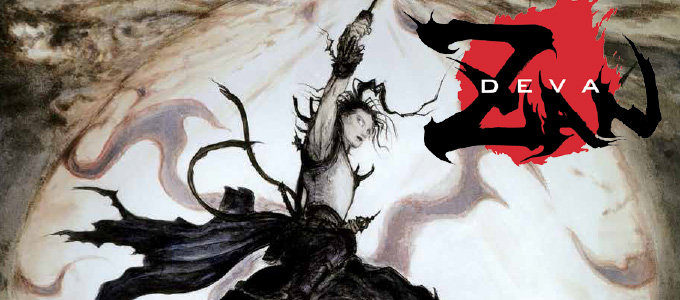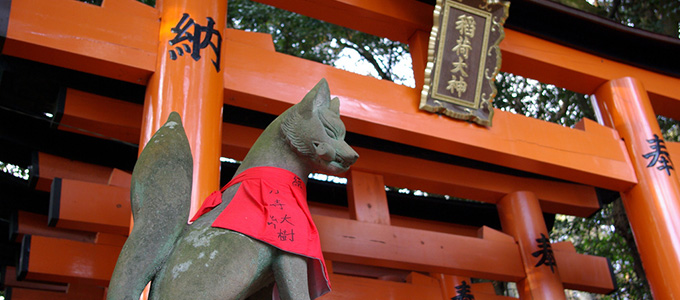
What Makes Japan, Japan?
“I still don’t understand Japan that well.”
Artist Yoshitaka Amano admits without hesitation that he is infatuated with US culture. He says he is not really good at making anything Japanese. With Final Fantasy, he was able to completely indulge in the expression of Western fantasy, and in doing so, gained a tremendous following from fans around the world. In his latest work “DEVA ZAN,” however, he takes on wholly the mysticism of the East that includes Japan.
“When we Japanese go to Europe, it is understandable that everything looks like a fantasy world, since each town is built within its own cultural context. We feel like we are flown into another dimension. In that manner, when the Japanese try to recreate a Western fantasy world, it ends up being a secondary fantasy that is seen through an Eastern cultural filter. Honestly, you can’t call it Western.”

“Once I worked on making insert drawings for The Tale of Genji*. I was researching some 1,200 year-old archives and found that they came with the original picture scrolls. I figured it would be pointless for me to do the same thing, so I just fooled around a bit and added a modern touch to my drawings. Surprisingly, something that looked Japanese emerged. I wondered, where did that come from? ”
“My father was a lacquer geta** maker of Shizuoka and he always worked from home. Ever since I could remember, I was surrounded by traditional crafts and was very familiar with them. I guess from the start I was subconsciously getting imprinted with the Japanese style. In the Western cultures, I prefer expressions like Art Nouveau that are originally influenced by the Ukiyo-e woodblock prints of Japan. Ultimately, I guess I am more drawn to styles that are born from the back and forth of cultures: the exchange.”
Through many of his creative processes, Artist Amano has participated in the cultural exchange between East and West. This is something that was a fantasy within itself in ancient times. For example, in 1999, he provided illustrations for British author Neil Gaiman’s fantasy novel The Sandman: The Dream Hunters.
“In The Sandman: The Dream Hunters, there is a monk that falls in love with a spirit of the fox. I went on a field trip to Fushimi Inari Shrine in Kyoto, since this was about a fox spirit. It is a shrine well known for having had a Buddhist temple inside of its property to worship both the Shinto Kami god and Buddha together up until the Meiji Restoration (1868). Then you wonder. Hmm? Kami and Buddha put in the same place together. That’s like taking the best of both worlds! (laugh) The Japanese have very little consciousness for distinctions in those areas. In some ways we are very irresponsible. We just keep devouring everything that comes in from the outside.”
“Kyoto is a town that is an archetype of Japan. Unlike Tokyo, there are plenty of old things still remaining. You can see history up close, yet trends and new things also get mixed in well. That is why I go visit Kyoto periodically. I go see temple paintings and Buddhist sculptures. What I do there is pretty modest stuff, but every time I go I have a new discovery. It is, after all, the roots of Japan.”
“Although I mentioned ‘Japanese roots,’ that doesn’t mean that I have done a lot of research in Japanese folklore or mythology. In fact, I am not even sure what the essence of Japan really is. Whether I was recreating an Eastern world or a Western world, it turns into something Japanese. I don’t read too deeply into that, but in my case, it just ends up being more Japanese.”
To find creative inspiration, Artist Amano visits Kyoto from time to time. The land he envisions now, however, seems to be beyond Japan and beyond the framework of what we call East and West. It seems to be connected to a mythical place where life originates.
“I think I just want to express a reality called mythology, whether I am using an Eastern visual method or a Western visual method. Mythology doesn’t only point to what is old. There are modern mythologies as well. The Buddhist mandala depicts the structure of the universe. The dragon is an imaginary creature that no one has ever seen, but we all want to believe in another era’s reality. From our current dimension it may seem like a fairytale, but no one can argue the validity of a totally different dimension that I might come up with.”
“Through the use of mythology, the ‘truth’ that I want to convey is that genuinely beautiful things are not made but are born. For example, if I’d compared the skeleton of a real animal and the one of a replica, the real one is exquisite all the way to the tip of the tail. That’s because it naturally begins at zero. It starts small and then spreads out into its completeness. On the other hand, no matter how perfect the replica is, the details falter and it ends up being unnatural.”
“Even if something is manmade, it could become beautiful as it comes closer to nature by time and weathering. I think the old towns of Europe look like they have become part of nature. Humans, too. We are beautiful just the way we are born. But the reality that what we create ends up being unnatural is a truth that I think we can’t change.”
* The oldest Japanese novel. Written by author Lady Murasaki (Murasaki Shikibu).** Traditional Japanese wooden sandals
(Interview: Manami Iiboshi, Translation: Mika Anami)

